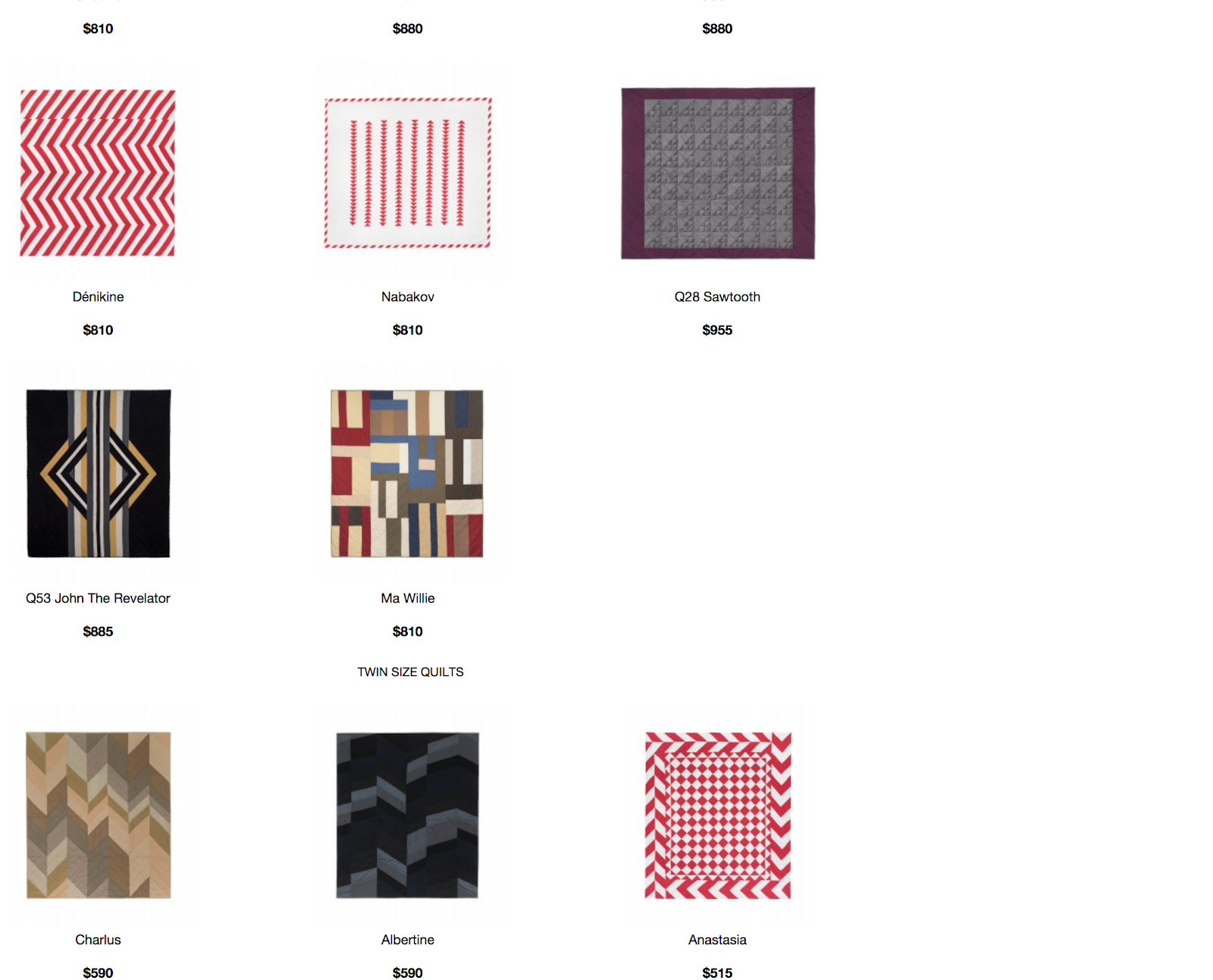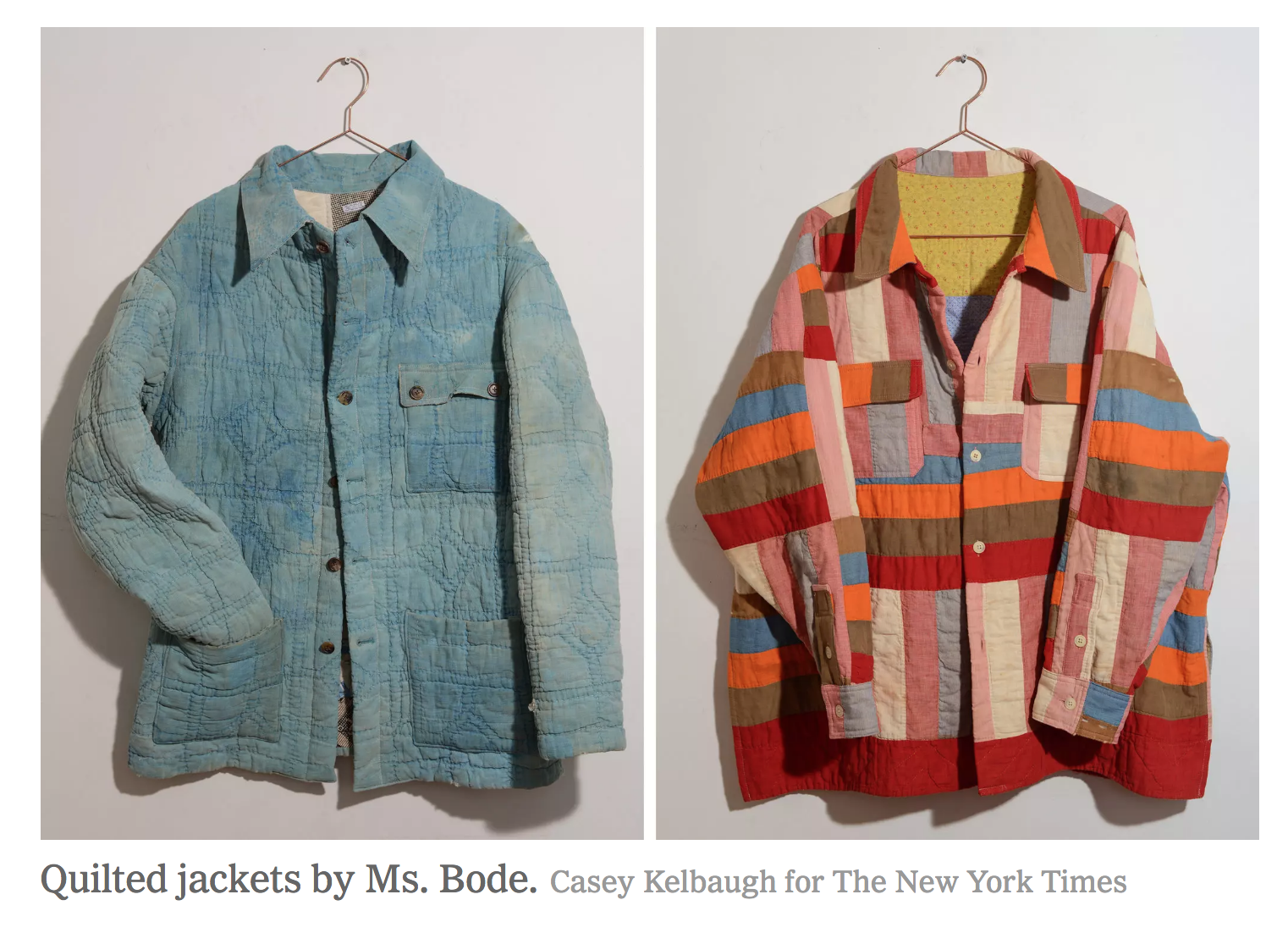Calvin Klein and Me
Having been around the quilt world for the last 40 years or so, I have seen the way quilts are occasionally picked up in the mainstream press as something newly rediscovered--it happens about once a decade. The last big splash was made by the explosion of coverage on the quilts of Gees Bend. Before that, it was the old order Lancaster Amish quilts. What these discoveries have in common is that the quilts uncannily resemble 20th century art, or modern graphics. I am sure you have heard the patronizing comments on these shows as often as I have: “And just think--she didn’t even know what she was doing!” or “They just used what they had…” These comments always, always, are meant to imply that since these quilts were made by little old ladies, they couldn’t possibly have been intentionally sophisticated, the effects they create had to be accidental, and only we sophisticated people can appreciate how cool they actually are. To hear people talk about the Gees Bend quilters, it sounds like people think they are blind and stupid: “They were just using whatever they could get their hands on and sewing it together any way they could.” (The quilters themselves sometimes foster this kind of thinking) That way, we do not have to consider the idea that this unschooled woman in this remote place could have such thrilling compositional skills from only her 50 years of experience making quilts.
No one knows how to explain that women in the mid-nineteenth century were able to create 6-foot-square abstract compositions 50 or 60 or more years before they became common in the art world, so they are reduced to a sort of reverse justification. “Looks like a Rothko,” or, I don’t know...Vasarely...Pollock. You’ve heard it. The idea is to deny the possibility that women of the 19th century could have known what they were doing. After all, they were just women, not designers. Not artists.
Okay. I have long come to terms with the idea that, since quilts were extra-academic, and since they were and are so widely made by women who did not go to art school, they were doomed to be confined to their ghetto...where winning the biggest prize in the quilt world would have absolutely no meaning in any other world. No curator or gallerist gives a hoot if you win Quilt National. Because of the unscalable wall between quilts and Art, we had to make our own museums. We had to create our own world where we can value each other’s creativity. That is my world and I am proud to be a part of it. Even today, when the walls between High and Low art are beginning to crumble, when the divisions between Art and Craft have less and less meaning, there is such a long way to go before quilt artists can get anywhere in the art world that I am resigned to the concept that I will not live to see the day when a quilt artist can be seen as an artist pure and simple. That is alright. I have had the great privilege of making my living here in this realm of women’s infinite creativity and generosity and mutual support. Even when I go way out on a limb with my explorations of what a quilt can be, I get nothing but support here in the quilt world.
But sometimes things bubble up through the fashion or art worlds that infuriate me. Take the recent Calvin Klein ad campaign. The company got a new creative director a year or two ago, Raf Simons, who has discovered American quilts of the 19th century, (obviously influenced by the Red and White show in New York a few years ago, although there is no mention of it anywhere I can find in his verbiage about quilts) and has been so taken with them that he is the latest in a long line of designers to cut them up and otherwise honor them by making clothes out of them. That is okay with me, I am inured to this sort of thing. Here is the real crux of it, taken from their website:
“Some arrestingly graphic, others intricately wrought, these heirloom objects are entrenched in America’s visual vocabulary, and synonymous in many ways with Chief Creative Officer Raf Simons’ vision for CALVIN KLEIN. At Simons’ debut for Fall 2017, vintage quilts lined oversized, utilitarian parkas, or became panel detailing on classic Wall Street topcoats; most recently they were seen on the Spring 2018 CALVIN KLEIN 205W39NYC runway, tucked under models’ arms.”
I love the idea that these arrestingly graphic, ….intricately wrought, ...heirloom objects are entrenched in America’s visual vocabulary, and synonymous in many ways with Chief Creative Officer Raf Simons’ vision for CALVIN KLEIN. I want to call Mr. Simons and ask how, exactly, are they synonymous? And if you value them so much, why do you advocate using them as floor coverings? Please also allow me to speak for the anonymous women of the 19th century when I say Thank You for using our humble quilts for your magnificent panel detailing.
Okay. I shouldn’t even get worked up over this. But then the New York Times has to publish an article about this latest fashion trend. https://www.nytimes.com/2018/05/09/style/blankets-quilts-fashion-trend.html
The article is so full of this kind of patronizing, nonsensical, bullshit statement that it makes my restraint fall away. Let me see…let’s start with the sub heading:
“The humble blanket, once a fixture of dusty antiques shops and flea markets, is now sold on Madison Avenue and in Paris boutiques.”
It’s humble alright. Just because 19th century American women completely abandoned the European high style of quiltmaking for the well to do and invented an entire realm of infinite creativity and creative freedom of expression, all the while doing it under the radar of men, by the brilliant innovation of making quilts a gift so there would be no money involved in their manufacture, so that oppressed and isolated women, prevented from participation in the worlds of commerce or politics by law and custom, could have entire artistic careers that lasted their whole lives if they wanted, just because they thereby birthed a Big Bang of creativity in the first half of the 19th century and invented this realm of quiltmaking we still enjoy almost unchanged today, just because they found ways of abstract expression that would go “undiscovered” for decades or a century by male artists, that is no reason to think of them as anything other than “humble.”
Moving on. “Calvin Klein features a red-and-white quilt in its provocative ad starring the Kardashian-Jenner sisters, who are languorously sprawled across the blanket in nothing but their underwear.”
I think we are supposed to be surprised at the wild juxtaposition of Kardashians--the utmost in fashion sensibility--and humble, dowdy quilts. And once again you can see how much CK and Mr Simons value their “hand selected” quilts (no kidding, that is what they say) by the way they place the boots on them.
Oy. Okay. Next paragraph.
“The French label A.P.C. sells a range of limited-edited quilts at its stores, alongside its utilitarian jeans and chicly no-frills shirts.”
Going to that company’s website you can find this statement: "Quilts to me are intrinsically linked to the past. They are made from yesterday’s fabrics, fabrics that we used and had leftovers of. In a way, quilts are to contemporary history what pottery is to ancient history.
I have chosen to name these quilts after the characters from Marcel Proust’s In Search of Lost Time. First, because it is about the passage of time, as are quilts, but also because my mother was an avid reader of Proust. The fact is that my love of quilts first came from her."
Jean Touitou
Leaving aside the fact that his quilts which are not based on stolen ideas from the--again--Red and White show are stolen from the Gees Bend quilts.( “Ma Willie”?) Or the others which are simply boring and as if designed by an indifferent beginner, Mr Touitou has to drag Proust into it. Because HIS MOTHER WAS AN AVID READER OF PROUST. Somehow his love of quilts first came from her. And “...quilts are to contemporary history what pottery is to ancient history.”? What does that mean? Why not simply say that he looked at some old quilts and used their designs? And then to watch the 4 minute movie on the A.P.C. website, which shows how the quilts are made in India, where the company is so uninterested in the quilters that we never see their faces or learn their names, only the names of the designers, is profoundly depressing. And let’s not forget that he is trying to give himself legitimacy by using Proust’s characters when he has never read a word of Remembrance of Things Past. 
I am going away from facts here. Allow me to get back on track. Next up:
“And Loewe, under the direction of its craft-happy designer Jonathan Anderson, showcased a collection of artisan-made quilts at the Milan Furniture Fair in April.”
Going to the link, we find another NY Times article that starts out like this: “The new capsule collection from Loewe’s Jonathan Anderson was born from the same sense of wonder with which the designer once marveled over his grandmother’s hand-knit quilts.” Yep, hand knit.
I shouldn’t be so picky about this...but it’s the Times! And then we learn that Mr Anderson scoured the earth to find artisans to make his vision come true, all of which are unnamed. Of course. I realize that no one needs to name the people in the design houses who actually do the sewing. But here are “artisans” actually doing the creating.
Next is “For me, this is how I relate to domestic life and how I relate to the emotions of a consumer,” said Emily Bode, a designer at Bode, a men’s wear label based on the Lower East Side of Manhattan that uses old fabrics for new designs. “To me, you’d want to wear it because of what is intrinsic to the fabric itself, it’s innateness.”
It is its innateness indeed. 
It is innately perfect for cutting up.
Ms. Bode says there is a physical and emotional comfort from quilts that resonates with her customers, who pay $1,500 for her one-of-a-kind boxy jackets made from dead-stock or found fabrics. “We had two customers who, the day they bought their quilt jackets, slept in them,” she said.
It is so much better to sleep in a jacket than under a quilt.
It goes on and on. All this is standard fare for these kinds of articles. Sophisticates justify using old quilts and the graphic ideas they contain using statements that imply that quilts were once made in a long ago, grandmotherly place, and that these sophisticates are now using them in this fun, quirky way to simulate some sort of interest in the past. By doing this they deny two things: first, they deny the profoundly significant creation of the American way of quiltmaking that arose in the 19th century and, second, they deny that there is any significance to its ongoing evolution and true connection to the past.
Millions of people make quilts today. And because of the brilliance of the women who made this realm and their idea that a quilt should be a gift made by a woman for someone she loves, an idea that kept quilts from ever being noticed by the men in charge, quilts that are being made today are still unnoticed. It’s a little comforting to think that our quilts might have the good fortune of being rediscovered a hundred years from now and used as rugs or cut up for jacket linings because of their innateness. (Maybe we will be so lucky that one of our quilts will get tucked under a supermodel’s arms on the runway!) But I would appreciate a little bit of critical thinking from a writer for the Times, my favorite newspaper. And I would appreciate the acknowledgement that quilts are in their 50th year of a major revival that has turned into an age, that they are not only “dusty” or “humble.”
Yes, yes, artists like Sanford Biggers can use old quilts any way he wants. Yes, yes, clothing designers can cut them up and use them any way they want. But please do not be so incurious about quilts that you do not even acknowledge on the business page, where the article above was found, that quilts are today an ongoing, huge business, with a sector in the billions of dollars. I would think that a little bit of digging would have given the writer the information that the enormous business of quilts today dwarfs any business related to quilts created or used by the designers in the article. I would think it would be fun to ask some quiltmakers what they think about the honor of having a quilt under the nearly bare bottom of a Kardashian. I would think that an article about the new visibility of quilts might not treat the world of quilts as invisible.


































